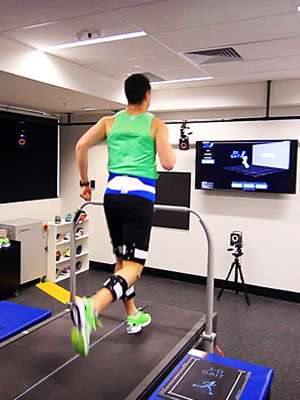How far can your shoes run?

Research data on the durability of running shoes challenges a common assumption.
Recreational and elite runners should take note: results of a collaborative study from Deakin University's School of Engineering and School of Exercise and Nutrition Sciences suggest that running shoes don't degrade as much as we might have thought.
Dr Paul Collins, from the School of Engineering, and Dr Jason Bonacci, from the School of Exercise and Nutrition Sciences, co-supervised the project, which extended previous research into the durability of running shoes by using human, rather than machine testing.
"The key takeaway is that shoes degrade initially up to 25 per cent of energy absorption effectiveness, but then they plateau," Dr Collins said.
"The degradation of the ethylene vinyl acetate (EVA) occurs very rapidly and then settles. Despite this rapid change in shoe properties, it had no influence on participants' running styles. Therefore, we think that runners can continue to use their shoes until other signs of shoe wear occur, such as deterioration of the rubber outsole or upper fabric."
As part of the study, 12 participants attended the School of Exercise and Nutrition Science's 3-D gait laboratory at Deakin's Waurn Ponds Campus for a 90-minute testing session. In the following weeks, they each ran 200km in their natural environment, then returned for an additional 90-minute test in the same running shoes.
"While participants were running on the treadmill, we examined their running kinematics and kinetics with our 3-D motion capture system," explained Rory Purdie, a researcher with Deakin's Centre for Sport Research who worked on the study with Dr Collins and Dr Bonacci as part of her honours thesis.
"By using retroreflective markers on participants' lower bodies, we collected data, monitoring changes in angles of joints, measurements of generated force and time taken to get through different segments of their stride," she said.
While no notable changes to the gait of participants were found, testing at 25-kilometre intervals did uncover key patterns in the degradation of shoe materials.
"The mid-sole foam of EVA breaks down all the weak bonds in the first 25 kilometres. From there on, it's solid material compressing on solid material, without the air bubble. While it can only compress so far, you do see a fatigue style of the mechanism of the material," said Dr Collins.
He noted that the research suggests that shoes are worn in by the 25-kilometre stage, and suggested that the frequency at which people replace their running shoes may be more about other factors such as outer sole and upper deterioration or, perhaps, changing fashions from season to season.
The ongoing collaboration between Dr Collins and Dr Bonacci in the field of sports technology is set to include 3-D print models later this year, with an intern joining the team in the coming months.
"Our 3-D shoe model will mimic the conditions of our recent study," Dr Collins said
"Under Armour, New Balance, Nike, and Adidas all have 3-D printed concept shoes in the market.
"These companies are pushing this technology, and we want to know if the newer models will degrade in the same way, since their composition is completely different.
"We can test that in comparison with current EVA midsoles to determine which performs better.
"Our goal is to find out how to elicit a better design, to create a product that interacts better with the people who wear it."
In addition to advances with 3-D models, the research team hopes to explore the associated biomechanics further, and pinpoint where energy from the generated force is absorbed.
"We would like to investigate where the energy goes, because we've found it's not going to the shoe," he said.
"We know it transforms to a different style of energy, and we need to find where that goes. We suspect that it may be referring to the joints of the runner. With the output from our recent work, and our previous studies on differences between barefoot and traditional shoes, we now have enough data to make a pilot study."
Provided by Deakin University


















